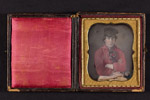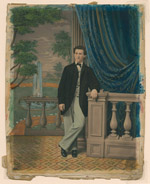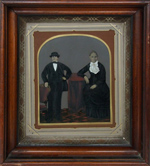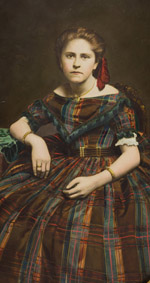Hand-Colored Photography
From the time of photography’s invention, those who experimented with the new technology sought to represent color in photographs. The hand-colored photograph would become a major artistic and social phenomenon that swept through all segments of society. In 1849, Samuel D. Humphrey, the author and editor of The Daguerreian Journal, wrote that coloring “created more popular clamor than all the other inventions combined.”
Hand-coloring was essential to the livelihoods of thousands of photographers. Portrait painters, their careers threatened by the rise of photography, quickly adapted to stay in business. Some became photographers, while others colored photographs for established photographers.
Despite their popularity, hand-colored photographs faced heavy criticism as hybrids. An 1859 instructional work on coloring photographs states that “Colored photographs occupy an undeservedly questionable situation: the artist curls his lips at them, and the photographer regards them with a sneer. The one says they are no painting, the other that they are no photograph; thus the art of photographic coloring, unrecognized by either, must seek consolation in the fact that it is embraced none the less eagerly by both.”
Hand-coloring helped to democratize an important status symbol of the time. The painted portrait had long been the exclusive privilege of the economic or social elite. Middle and working class families could now afford to have “painted” portraits of themselves and their loved ones. Folk art portraiture, far from disappearing as a result of photography, embraced the new medium of photography, helping both to flourish in the form of the hand-colored portrait.
 |
Young Man in Red Blouse. ca. 1850. [zoom] Hand-colored daguerreotype, sixth plate Hand-coloring of photographs dates to the earliest forms of photography, as seen in this colored daguerreotype. The practice continued for over 110 years. |
 |
Unidentified. Young Man, 1864. [zoom] | Additional images:  Salted paper print and hand-colored salted paper print, 8 1/4 x 6 1/4 in. By 1864, when this photograph was taken, the use of albumen paper was commonplace in photography. This photographer nevertheless chose the older salted paper process because its mat surface was more receptive to paint. This pair of photographs shows that the quest for verisimilitude sometimes involved not only adding color but also placing the subject in a naturalistic setting. |
 |
Holmes, Booth & Haydens. African-American Woman with Two White Children, 1860s. [zoom] | Additional images:  Hand-colored ambrotype, 1/4 plate and hand-colored salted paper print, 9 x 7 in. This photograph of a white child and a slave nanny is a reminder of the complexities of interracial relationships during the era of slavery in America. The portrait was of sufficient importance to its owner to merit production of duplicates. The first image is an ambrotype, a one-of-a-kind positive image. The second is a salt print duplicate made from a photograph of the original ambrotype resulting in a copy negative. The use of hand-coloring allows the photographer to restore detail lost in the reproduction and enlarging process. |
 |
Unidentified. Painted Tintype Composite in the Folk Art Style, ca. 1870. [zoom] Hand-colored tintype, full plate Hand-colored photographs varied widely in quality and style, from examples of the highest refinement to those of comically low quality. The obvious difference in scale between the man and the woman in this photograph suggests that this is a composite of two photographs placed side by side and photographed to create a crudely joined tintype. The artist painted over the floor and background to hide the seam and extended the man’s elbow into the woman’s half of the photograph. This joining of photographs was a useful technique for those who lost a loved one before they had the opportunity to take a photograph together. |
 |
Unidentified. Young Woman, 1850s. [zoom] Hand-colored salted paper print, 21 x 15 7/8 in. Hand-coloring ranged from lightly tinting cheeks or adding a sparkle to the eye to masterfully applied paints to create portraits virtually indistinguishable from a traditional painting. This lavishly painted photograph portrait demonstrates the merging of the two arts. |
 |
Charles D. Fredricks. Young Woman, ca. 1858. [zoom] Hand-colored salted paper print, 3 ½ x 2 ½ in. |